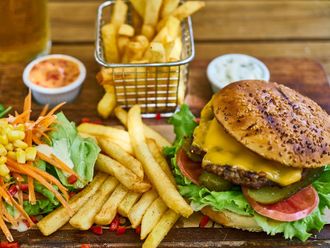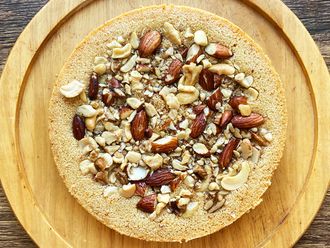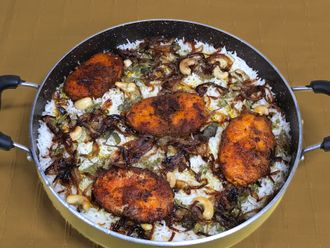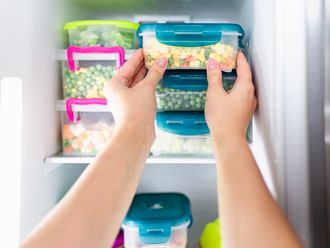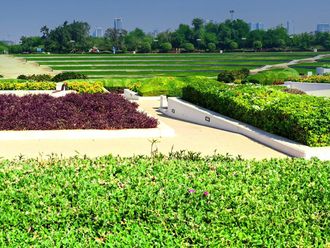Pink Himalayan salt blocks don’t come from the Himalayas and won’t stay pink after they are put to their best use, grilling.
Those are just two of the surprises revealed in Mark Bitterman’s latest cookbook Salt Block Cooking: 70 Recipes for Grilling, Chilling, Searing and Serving on Himalayan Salt Blocks. Part cookbook, part how-to guide for using the alluring kitchen tool, the book is an ode to the luminous blush squares that can be used on the grill or in the oven and have begun turning up in gourmet kitchen stores and in top restaurants.
Bitterman, whose previous book Salted won the James Beard Award and who owns The Meadow, a specialty food store in Portland, Oregon, and New York City, spoke from Portland about the cooking sensation that’s nearly as luscious to look at as the food prepared on it tastes.
Is the idea of cooking and serving on salt blocks new?
It’s less than a decade old. Its discovery is a little shrouded in mystery. I think there was some opportunistic cooking maybe on salt stones in ages past. But in terms of salt-block cooking the way we think of it now, all evidence I have is that it’s an American invention.
In your book, you explain that Himalayan salt is actually from mines in Pakistan. How did it first come to the United States?
It was big with the health food movement in America, which is because it’s unrefined. It was ground up and used as a culinary salt or a bath salt. It was also carved into shapes and used as salt lamps. They were pretty and there was a belief that on lighting these things up, they shoot ions into the air.
What happened that moved us to cooking and serving on salt blocks?
Probably a salt lamp found itself being cooked on. It’s the same salt, the same salt deposits. Folks started to have them sliced into blocks and bricks and put food on them to see what would happen.
What hooked you on cooking with salt blocks?
These unusual chemical reactions happen by cooking on hot salt that you just can’t replicate any other way. With duck breast, it produces a texture of crispy duck skin that is better than anything you’ve ever had. With scallops, it’s just the most remarkable crispy golden crunchy browning of a scallop. It’s a technically superior way to cook something.
What reaction do you get when you serve someone food for the first time that has been cooked or prepared on salt blocks?
Excitement! At fancy dinner parties, people will burn their fingers because they are so excited just to move their food around on a salt block. They want to touch it. There is a tactility and an immediacy to having this giant white hot block of 600-million-year-old salt on a table that turns us all into apes. It’s just this gorgeous, luminous thing.
What about the blocks that have been used on a grill, which may lose their pink colour and turn tan or off-white?
It’s still pretty impressive. It’s not just culinary, there is also a great entertaining factor. It’s conversation: ‘This salt block is older than the land mass that we’re eating dinner on. The oldest piece of food on the face of the earth.’
What is the hardest thing about preparing food with salt blocks?
Understanding the fundamentals so you season your food to perfection. Understand the basic dynamics of what’s happening.
For raw food, the three basics are moisture, the surface area and the amount of time in contact with the salt block. That means a piece of watermelon laid flat on a salt block is going to get much saltier than watermelon fanned on a salt block.
When you’re cooking, you have the fourth variable, which is the temperature of your block. The hotter the block, the quicker it sears the food and seals in the moisture. One of the most common mistakes in cooking with salt blocks is to not get the block hot enough. (In his book, Bitterman recommends gauging temperature by spattering water on a hot salt block to test how quickly it evaporates.)
What’s the best way to clean your salt block?
Washing is one of the challenges to getting the most out of your block. We tend to think of it as a kitchen utensil so you wash it under warm water but all that does is find the most soluble parts of the block and erode them really, really fast and reduces the lifespan of your block.
The way to deal with it is to wipe it off with a moist sponge or towel and you’re good to go. It’s super, super anti-microbial. So there is no fear of getting every single last bit of organic matter off of it. It makes dish soap seem like warm milk by comparison. By its nature, it’s the most sanitary thing you’ll cook on.
Do many people mistake you for Mark Bittman, the food columnist for The New York Times?
Yes and I usually let that slide. I met him once and he joked, ‘Don’t move to my building! I lose enough mail as it is.’
WATERMELON AND FETA ON A SALT BLOCK
Serves: 2
INGREDIENTS
1 (8 by 12 by 2-inch) salt block platter
4 (1/2-inch-thick) quarter slices large watermelon, rinds removed
85g feta, crumbled
6 fresh mint leaves, slivered
Chill the salt block platter in the refrigerator for at least 2 hours.
Arrange the melon slices on the block, slightly overlapping — the more the overlap, the less salt imparted to the melon.
Scatter the feta and mint leaves on top. Serve immediately. For added pop, allow the dish to stand 20 minutes before serving.



